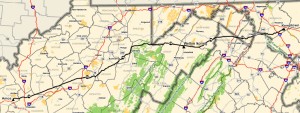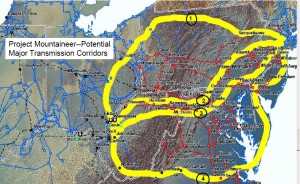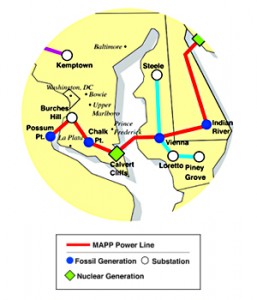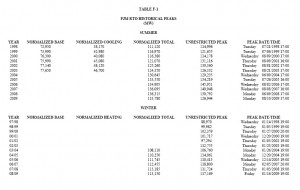PATH transmission line WITHDRAWN!!!!
February 28th, 2011
The application for the Potomac Appalachian Transmission Highline, PATH, has been withdrawn. Notice was just sent out, not long after PJM issued a press release saying that PATH was “delayed.”
And here’s the one we’ve been waiting for, Potomac Edison’s Notice of Withdrawal (that didn’t take long!):
I’m looking on the PJM website, and can’t find the 2010 RTEP, so I call the number on the bottom of the Press Release, 866-756-6397, wanting to know where the 2010 RTEP is (one of the attorneys on the Susquehanna-Roseland line had asked about that, and I was stunned I couldn’t find it!!!), and when the 2011 RTEP is due out. No one can help, they’re in a meeting, “anyone that could help you is in a meeting.” Someone will call back… Uh-huh… right…
What they say is what we’ve been saying for how long?
PJM annually reviews its transmission expansion plans. A preliminary analysis suggests that the need for the line has moved further into the future. Therefore, the PJM Board has decided to hold the PATH project in abeyance in the 2011 Regional Transmission Expansion Plan (RTEP). The preliminary analysis used the most current economic forecasts, demand response commitments and potential new generation.
…
Over the last two years, the recession and the dramatic change in the economic outlook caused PJM to forecast lower growth in the use of electricity. Growth in the use of electricity correlates with economic growth. The forecasted slower growth rate likely will delay the need for the line.
So now, how to find that 2010 RTEP???
PATH transmission challenged by WVa PSC staff
December 18th, 2010
Click map for larger version:
PATH, the Potomac Appalachian Transmission Highline, is in trouble… AGAIN…
The good news is that the West Virginia Public Service Commission staff is challenging need for the PATH line, which was already postponed by PJM. And then there’s these pesky states questioning the need, like Maryland, which challenged the corporate organizational form, noting that it wasn’t a utility so “get outta here!”
Now it’s time for the West Virginia PSC staff to raise its eyebrows and deliver a solid Motion to Dismiss:
For the entire docket, go here:
And here’s the way it looks in the press:
$2B PATH project faces dismissal by W. Va. regulators
PJM shell game continues
October 14th, 2010
This week, PJM has “decided” that part of the humongous 500kV buildout isn’t necessary. Well DUH, but…
PJM Press Release – PJM Board authorizes $18 billion in transmission upgrades
And so please explain why the headline isn’t “PJM Board cancels 500-kilovolt (kV) line connecting the Branchburg, Roseland and Hudson substations in northern New Jersey.”
From that PJM board meeting, there was a presentation that looks like a corporate-style WAKE UP call:
Meanwhile, I’m trying to find the primary documentation, something with specifics about what was “approved” and what was “removed” and the basis for it… nada… nothing that I can find on the site. Something else irritating is that when I’m looking up documents on the PJM site, I often just get a blank black page, particularly from the TEAC site.
One interesting presentation was about a Market Efficiency Analysis, in 2014 without Mid-Atlantic Power Pathway (MAPP), Potomac-Appalachian Transmission Highline (PATH), Branchburg-Roseland-Hudson and Susquehanna-Roseland, and from then on without the Branchburg, Roseland and Hudson line:
2010 Market Efficiency Analysis Results Updates – October 6, 2010
And when I try to get closer to the Northern NJ documentation… well, tell me if YOU can get anything:
“File is damaged and could not be repaired.” So I called the number on the PJM press release to see… and was told they’ll call back. Yes, we shall see…
FERC cost-apportionment docket heats up
February 24th, 2010
The cost apportionment remand at FERC is heating up. It’s that case where the 7th Circuit threw out the PJM cost apportionment scheme:
It went back to FERC and so FERC issued an Order requiring PJM to produce things that… well… things that will demonstrate that there’s no need for this project, things that will demonstrate the benefactor of these transmission lines, things that PJM doesn’t really want the world to know, like how they’ve incorporated O-P-T-I-M-I-Z-A-T-I-O-N, things going directly to N-E-E-D!
Seeing that, well, Stop the Lines had to join in, as did the Municipal Intervenors:
PJM begged for more time, an extension of 45 days!
And for some bizarre reason, FERC gave it to them:
Meanwhile, Exelon wants to bring in the kitchen sink, including 345kV transmission:
And parties they are a freakin’ and filing:
And then the weirdest of all – the American Wind Energy Ass (AWEA) wants to intervene, citing “the current significance of this issue in the context of efforts to build transmission to bring location-constrained, renewable resources to load…” Ummmm… SAY WHAT??
OK, I give up… in what parallel or alternate universe is the PATH or Susquehanna-Roseland line for wind? WHERE DO THEY GET THESE IDEAS? I want to see the basis for that statement. PRODUCE!
Earth to AWEA — can you spell P-R-O-J-E-C-T M-O-U-N-T-A-I-N-E-E-R?
If you need a hint, go to FERC eLibrary and search for A05-03. Happy reading!
That line’s going to fall in my living room…
January 24th, 2010
MID-Atlantic Power Pathway and all of PJM’s “backbone” projects in the news:
She’s worried about a larger line rising in the shadow of her house. If the poles somehow get knocked over, “Where’s that line going to fall? That line’s going to fall in my living room.
That’s Farah Morelli’s question. She’s a regular person who woke up one day with a monstrously large transmission line planned literally in her back yard. That’s usually the most effective way to get someone to learn about transmission. It’s a steep learning curve, and what I’ve found in my work with people in the path of proposed transmission is that once they start looking, they find a disturbing fact: Utilities propose transmission lines not because they’re “needed” but that they’re wanted, wanted to increase their ability to transmit and SELL cheap power in areas where it’s higher cost, and make a bundle in the process. It’s not that people don’t have electricity (and high price is the best instigator of conservation), but it’s that people want more and want it cheaper and the utilities which make $$$ from that equation want to make it happen.
HERE’S THE REALITY — The PJM 2010 Load Forecast Report and the Monitoring Analytics “PJM 3Q State of the Market” report show that this market decline isn’t anything new and that it’s not going away anytime soon. The PJM market peaked in 2006:
Today’s News Journal article is a start at pulling it all together, taking a look at the bigger picture, and that bigger picture is what these transmission lines are all about. Three lines were proposed together, the Potomac Allegheny Transmission Highline (PATH), the Mid-Atlantic Power Pathway (MAPP) and the Susquehanna-Roseland line. These aren’t just transmission lines, they’re BIG HONKIN’ ELECTRICAL AUTOBAHNS, quad (or now maybe tri?) bundled 500kV lines. Like WOW. HUGE!
Here’s today’s article:
Lower energy projections put brakes on power lines






